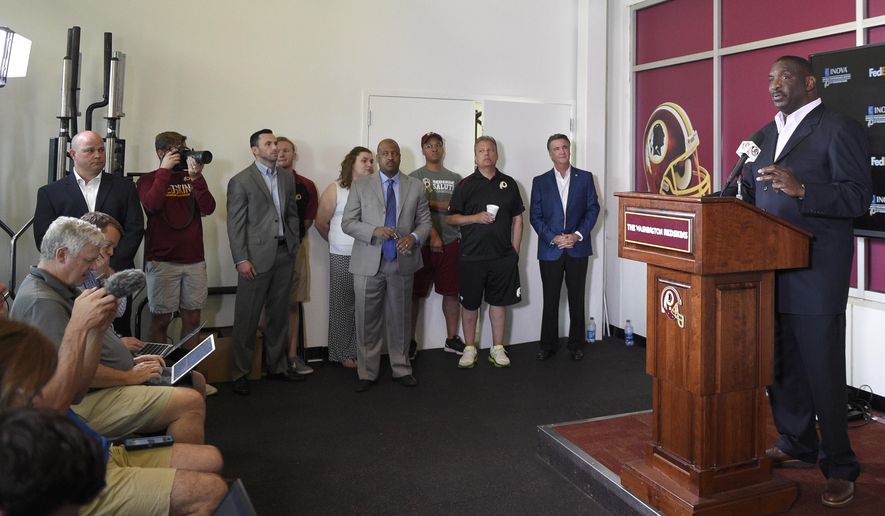One of the most important changes to the Redskins personnel department wasn’t represented at the podium when the team announced the slew of promotions last week. In fact, it wasn’t represented in the building – yet.
The Redskins are in the process of hiring several new scouts. That process was said to be nearing its finish when Doug Williams was named senior vice president of player personnel last Tuesday. Whether you think the changes at the top were good, bad or nominal, Washington felt it needed more manpower in scouting, and is addressing that need.
“You just get more information [with more scouts],” said Kyle Smith, newly-minted director of college scouting and a former area scout who, with Williams and assistant director of pro scouting Tim Gribble, is making the hires. “It just helps with the process and it’s something that with Doug [Williams] and [Redskins President] Bruce [Allen], their vision to expand the department, it’s something we needed here. We needed to frickin’ revamp. That’s what we’re doing and it’s exciting.”
A look through the scouting personnel listed in 2016 media guides revealed that the Redskins tied with the Titans for the fifth-fewest employees involved in scouting among the league’s 32 teams. On average, teams had 17.72 employees with key involvement in scouting and personnel evaluation, from general managers down to interns. The Redskins had 15 — including ousted general manager Scot McCloughan.
Below the director level, the college and area scouts who do the bulk of the work compiling reports over the course of the year, the average NFL team employed 10.68 last year. The Redskins had nine.
That relatively small group of people shouldered the work leading up to the draft, when they also had to compensate for the loss of McCloughan. All of the Redskins area scouts and senior personnel executive Scott Campbell, who was director of college scouting at the time, came back a week early after free agency to play catchup on draft evaluations.
“We needed to reassess every player that we were going to consider on our draft board,” Allen said. “We had our area scouts, we had them have to do extra work. We had to do cross-checks. We were short on a number of reports for this draft and they did a great job of working extra time to evaluate.”
There is inexact science at work in assigning an exact number of employees to each personnel department. Each team divvies up responsibilities between front offices, scouting departments and football operations or administration departments differently. Some staffers whose listed job descriptions may not involve scouting still get involved in the process.
For example, coach Jay Gruden is not a member of the Redskins personnel department or front office even though he does play an important role as an evaluator. At the combine this year, Gruden led the team’s player interviews.
Quantity in scouting does not equal quality, either. Three of the four teams with the smallest scouting staffs in the league – the Seahawks, Texans, Bengals and Steelers – won their divisions in 2016. The team with the largest scouting department? The Browns, with 28 people involved in evaluations.
There is a limit to how streamlined a scouting department can be, though, when the goal is to get multiple sets of eyes on a country full of players.
“To ask one guy to do a whole west region, it’s hard,” Gruden said. “You have got to have cross-checks. You have to be able to get the background information, as much information as you can, on the individual. Then you have got to get the player – how they do as a player – and get their opinions on them and talk to the coaches.
“There is a lot that goes into writing up a player and the more opinions you have on them, expert opinions, the better it will be. You’re never going to be 100 percent together on each and every player, but the more opinions you have, the better you will be — especially quality opinions.”
When a team makes scouting hires in the summer, one concern is usually that all the best candidates have been scooped up. Smith said that the quality opinions Gruden wants are still out there, even though the Redskins are “a little bit behind.”
“There’s some really good scouts with experience that are still available, which is great,” Smith said.
Particularly in college scouting, getting people in place in lower-level positions will free Smith, Gribble and Campbell to focus their attention on top prospects. Smith, who was based in Atlanta as an area scout covering the southeast, is moving to the D.C. area and will focus his attention nationally, along with Gribble and Campbell.
Smith’s goal for next February, when the Redskins do a first full assessment of their draft board, is to have three or four grades on all top players. He believes more cross-checks will not just give a better picture of talent, but of character as well.
“Between the three of us,” Smith said. “This is something we haven’t had here in a long, long time.”
• Nora Princiotti can be reached at nprinciotti@washingtontimes.com.




Please read our comment policy before commenting.